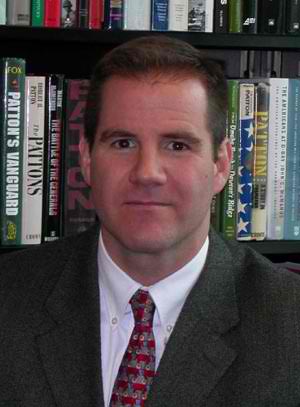 Lieutenant General Walter “Beetle” Smith signs the German surrender document on behalf of the Allied high command on May 7, 1945. On his right is Admiral Harold Burrough, commander in chief, Allied Naval Expeditionary Forces. On Smith’s left is Major General Ivan Susloparov, representing Soviet forces, and General Carl Spaatz, commander of U.S. Strategic Air Forces in Europe. (Credit: Library of Congress)
Lieutenant General Walter “Beetle” Smith signs the German surrender document on behalf of the Allied high command on May 7, 1945. On his right is Admiral Harold Burrough, commander in chief, Allied Naval Expeditionary Forces. On Smith’s left is Major General Ivan Susloparov, representing Soviet forces, and General Carl Spaatz, commander of U.S. Strategic Air Forces in Europe. (Credit: Library of Congress)
To commemorate the 75th anniversary of Victory in Europe (VE) Day, today we spotlight U.S. Army Lieutenant General Walter Bedell “Beetle” Smith (1895-1961) who is buried in Section 7 of Arlington National Cemetery (ANC). The name “Beetle” Smith may not be as well-known as other names of World War II generals, such as Marshall, Eisenhower or Patton. However, Smith played a key behind-the-scenes role in Germany’s surrender to the Allies on May 7, 1945. His story is just one example of how learning about individuals buried at ANC provides a deeper insight into important historical events and experiences.
Smith served as General Dwight D. Eisenhower’s chief of staff, first in North Africa, Sicily and Italy, and then at the Supreme Headquarters Allied Expeditionary Force (SHAEF) in England and France. As the war in Europe finally wound down in the spring of 1945, Eisenhower refused to negotiate with the Germans and delegated the task to Smith.
After Adolf Hitler committed suicide in his Berlin bunker on April 30, 1945, Admiral Karl Dönitz took over as head of the German government. Dönitz hoped to buy time for Germany to surrender to the Western Allies (the United States, Great Britain and Canada) and escape the onrushing Soviet Army. He thus sent Admiral Hans-Georg von Friedeburg to the Western Allies to arrange surrender terms.
On May 5, 1945, Admiral Friedeburg and a few associates arrived at Eisenhower’s headquarters in Reims, France, and met with Smith, who told Friedeburg there was nothing to discuss except the immediate surrender of all German forces. Friedeburg protested that he did not have that kind of authority and that surrendering to the Soviets was unthinkable. Smith told him that if the Germans surrendered on all fronts they would receive better treatment under the laws of war. If Germany refused to completely surrender, Smith threatened to seal the western front from refugees and surrendering German soldiers. Smith then told Friedeburg to either sign the surrender documents or get someone who would.
Friedeburg then contacted Dönitz, who sent General Alfred Jodl to Reims on May 6. When Jold met with Smith, he agreed to surrender only to the Western Allies but not to the Soviet Union. He asked for twenty-four hours to contact German army front-line units. Smith refused and explained to Jodl that if he did not sign the surrender for both fronts before midnight, he would seal the western front.
Later, speaking to Jodl soldier-to-soldier, Smith explained that surrendering quickly would preserve the honor of the German Army and would protect officers under the Geneva Conventions (international protocols that governed the conduct of warfare). Jodl still pushed for more time. When Eisenhower learned of Jodl’s pleas, he said he would seal the border in forty-eight hours, even with no signature. After conferring over the phone with Dönitz, Jodl agreed to end hostilities one minute after midnight on May 9, 1945.
Early the next morning, May 7, Jodl walked into the second-floor War Room, stiffly bowed to the Allied generals around the table, and sat directly across from Smith. Friedeburg sat to Jodl’s left. On either side of Smith sat the military representatives from the United States, Great Britain, the Soviet Union and France.
Smith asked Jodl if he was ready to sign, and the German finally agreed. With that, Strong placed the surrender documents in front of Jodl, each in a different language. Once signed, they were passed to each general for their signatures. Before signing the last document, Jodl requested to speak. He emphasized the German people’s and military’s suffering and asked for generosity. Smith made no reply and the signing continued.
When the signing process ended, Smith and Strong took Jodl to Eisenhower’s office to announce that the war in Europe was over. Hitler had waged war for almost six years. Under his leadership and authorization, the Nazi regime murdered and tortured millions of people, perpetrated the massive genocide of the Holocaust and destroyed large swaths of Europe. Now, Germany had been defeated and Lieutenant Walter “Beetle” Smith had helped orchestrate its surrender. Arlington National Cemetery honors his leadership in making VE day possible.
 General Smith's grave marker in Section 7
General Smith's grave marker in Section 7
TO LEARN MORE
- D.K.R. Crosswell, “Beetle: The Life of Walter Bedell Smith.” (University of Kentucky Press, 2010)
- Major-General Sir Kenneth Strong, “Intelligence at the Top: A Recollection of a British Intelligence Officer.” (Doubleday & Company, 1969)
 Author: Kevin Hymel, Historian
Author: Kevin Hymel, Historian